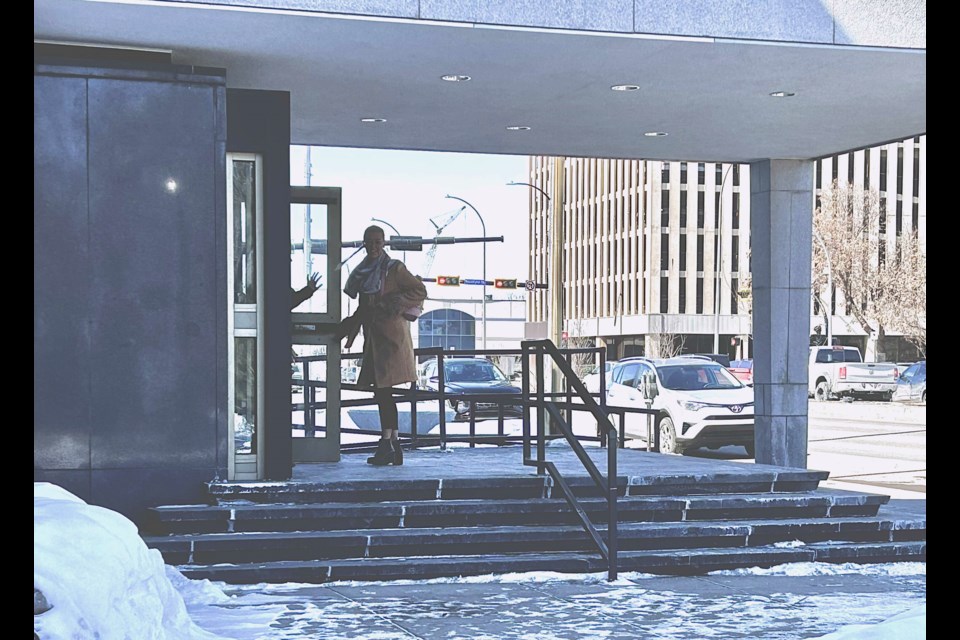REGINA – The Whitby murder trial wrapped its second week in Regina Court of King's Bench, focusing on highly technical testimony from the medical field.
This morning, Court heard from expert radiologist Dr. Mohammed Nayeemuddin, who interpreted the CT scan performed on Emerson William Bryan Whitby on June 10, 2020, which showed results from his brain, neck, abdomen, and pelvis. Emerson was rushed to Regina General Hospital that morning after discovered non-responsive by his mother, Chelsea Rae Whitby. She is also the accused in this trial, with a charge of second-degree murder in relation to Emerson’s death.
While going into great detail as to which parts of Emerson’s brain were affected and how, Dr. Nayeemuddin found swelling that caused a midline shift of 10.2 mm from the right hemisphere into the left and blood 7 mm thick in the subdural region. He also explained how grey-white matter differentiation allowed him to declare a cytotoxic edema
“I was at the CT scanner at the time, doing a procedure at the time,” Dr. Nayeemuddin explained, when Emerson was brought in - intubated and using a ventilator to breathe.
With blood not able to reach the brain, there’s mere minutes before irreversible damage occurs, according to Dr. Nayeemuddin. Crown prosecutor Adam Breker referred to how Emerson’s heartbeat returned through the efforts of EMS personnel prior to him being taken to hospital, and posed the question if that action would prove to be a factor.
“It depends on when the heartbeat had comeback,” Dr. Nayeemuddin replied. “If the duration is more than five minutes, the damage is already done.”
He also explained how the intracranial pressure builds, not allowing blood to flow through the carotid arteries to supply the brain.
Dr. Christopher Robinson, a neuropathologist based in Saskatoon also spoke to the difficulty in pinpointing the time of brain death.
“Another big variable, clinicians don't know what time blood flow into the brain stopped,” he said, adding that even arranging the definitive test to determine clinical brain death takes time. In fact, several hours may have passed since blood was flowing to the brain; one “can’t be dogmatic with these time estimates” as Dr. Robinson said.
Dr. Robinson received tissues from Dr. Nistor after the autopsy. Again, his testimony was quite detailed, but Breker also asked some general questions for clarification - such as what his definition of "trauma" meant to him.
“Trauma, in this case, is any force directed at and hitting the head,” Dr. Robinson said. “Could be a bump on the head from a cupboard door to a motor vehicle accident.”
During cross-examination, defence counsel Darren Kraushaar explored different avenues pertaining to head trauma. In his line of questioning, Kraushaar confirmed with Dr. Robinson that an accidental fall could cause a subdural haematoma. He further theorized that a child might fall, receive and injury and recover, or have a short fall and pass away. Dr. Robinson agreed both scenarios could possibly occur.
Dr. Nayeemuddin also spoke to the fracture on the back of Emerson’s skull, which Dr. Andreea Nistor referenced during her testimony during the previous day. Breker asked Dr. Nayeemuddin how long such a fracture would require to heal; when the fracture might no longer be visible.
“Usually these skull fractures take approx three to six months for complete healing,” he said of the fracture to the occipital bone. “This could be any time between then.”
Interspersed between witness testimony this week, a video of an Aug. 5, 2020 in-custody statement with Whitby was played. The timing of the statement was a day after she had been arrested, then facing a manslaughter charge. This charge would later be upgraded to one of second-degree murder in 2021, leading to the current three-week trial.
A plain clothes member of the Major Crime Unit conducted the interview with an obviously emotional Whitby. He began by asking how she was feeling, with Whitby replying, “ripped into a million pieces.”
“I didn't imagine my life like this when I was 12 years old,” she said.
During the interview, the officer illustrated the four people who had contact with young Emerson in the 24 hours preceding his death - being Whitby, her then boyfriend Taylor Stewart, Whitby’s mother (Lisa Virtue), and Emerson’s father, Riley Jolly. At that point, Jolly had already participated in a polygraph test, Virtue was not at the residence since putting Emerson to bed the previous evening, and Stewart had left the apartment to get milk on the morning of June 10, 2020. This left a moment in time where Whitby was the only adult in the residence with Emerson.
When asked about that approximately 20 minutes where Whitby was alone with the children, she explained preparing some fruit for a snack, bringing the tray of cut fruit to Stewart’s girls on the front deck, then having a cigarette before realizing the time was 10 a.m. That was when she went to check on Emerson, finding him unresponsive.
At one point int he interview, the officer informed Whitby that Emerson had suffered a subdural haematoma, not thought to be caused by CPR efforts. He mentioned an “acceleration deceleration injury,” previously referred to as Shaken Baby Syndrome.
“I don’t shake my child!’ Whitby replied, exasperated.
“What is your biggest fear of this whole thing?” The offer asked Whitby at one point.
“Being charged, going to jail, and ruining my life,” she replied.
The trial is expected to conclude at the end of next week.
— Click for more from Crime, Cops and Court.





